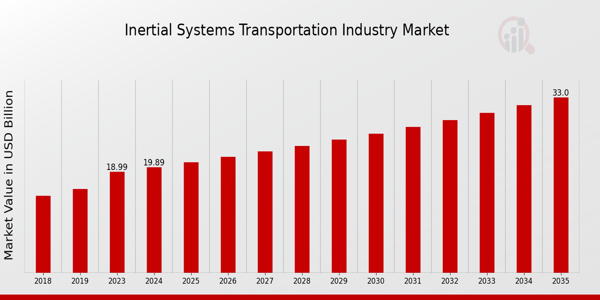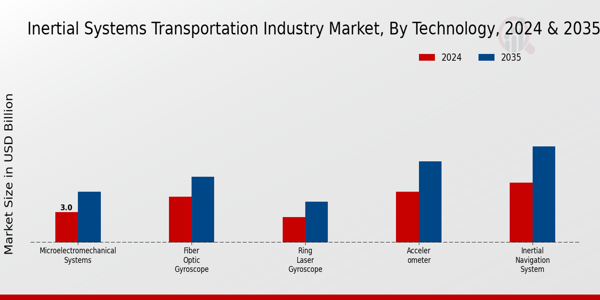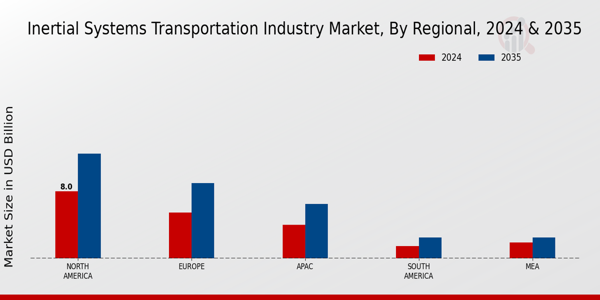Inertial Systems Transportation Market Overview
Inertial Systems Transportation Market Size was estimated at 18.99 (USD Billion) in 2023. The Inertial Systems Transportation Market Industry is expected to grow from 19.89 (USD Billion) in 2024 to 33.0 (USD Billion) by 2035. The Inertial Systems Transportation Market CAGR (growth rate) is expected to be around 4.71% during the forecast period (2025 - 2035).

Source Primary Research, Secondary Research, MRFR Database and Analyst Review
Key Inertial Systems Transportation Market Trends Highlighted
The Inertial Systems Transportation Market is experiencing significant growth driven by increasing demand for accurate navigation and positioning systems. The rise of autonomous vehicles and the need for enhanced safety features in transportation are key market drivers. Companies are focusing on advanced technologies that improve the reliability of these systems, making them essential for modern transportation. The push for greater efficiency and the integration of inertial systems into existing infrastructure further support this growth. Opportunities in this market are plentiful, particularly due to the expanding use of inertial sensing technology in various applications.
Many sectors, including aerospace, automotive, and maritime, have started utilizing these systems for operational efficiency, and this trend is backed by developments in sensor technologies, innovative approaches, and lower-cost options. A combined effort between the transportation industry and technology vendors can deliver tremendous business opportunities with the development of more focused and industry-specific solutions. Current developments indicate an increasing focus on integrating and shrinking the size of these systems alongside other technologies. These developments allow more sophisticated interactions with the inertial systems, becoming an integral part of modern transport networks.
Emerging markets are also starting to embrace these technologies, further broadening the potential customer base. Sustainability factors are influencing design and manufacturing processes, with a focus on creating greener solutions. The shift toward smart transportation systems underlines the importance of inertial systems in supporting this transformation, making them indispensable for the future of transportation.
Inertial Systems Transportation Market Drivers
Advancements in Inertial Navigation Technology
The Inertial Systems Transportation Market is significantly driven by ongoing advancements in inertial navigation technology. This includes improvements in sensor accuracy, miniaturization of components, and enhanced data processing algorithms. As these technologies evolve, they enable more precise navigation and positioning capabilities across various modes of transportation, including automotive, aerospace, and marine sectors. The demand for efficient and reliable navigation systems is on the rise, propelled by the increasing complexity of transportation networks and the need for safety in operations.
Furthermore, advancements in artificial intelligence and machine learning are being integrated into inertial systems, allowing for better real-time data interpretation and decision-making capabilities. The industry's focus on autonomous systems and smart transportation solutions is also a driving force as companies look to leverage these technologies to enhance operational efficiency and reduce costs. As consumer expectations evolve towards safer and more connected travel experiences, the Inertial Systems Transportation Market is poised for growth, with innovations that improve both user experiences and overall system performance.
Investments in research and development within this sector are expected to yield new applications and methodologies, further supporting the market's expansion in the coming years.
Rising Demand for Autonomous Vehicles
The increasing demand for autonomous vehicles is a significant driver for the Inertial Systems Transportation Market. As automakers and technology companies invest heavily in developing self-driving technologies, the need for robust and reliable inertial systems becomes paramount. These systems are essential for accurate navigation and positioning in autonomous setups. As regulations evolve to support the deployment of autonomous vehicles, the market is expected to grow rapidly.
Growth in Smart Mobility Solutions
Smart mobility solutions are gaining traction worldwide, presenting a fertile ground for the growth of the Inertial Systems Transportation Market. With the integration of smart technologies into public transport and personal transportation, there is a rising need for sophisticated inertial systems. These solutions not only improve navigation and route optimization but also enhance safety and efficiency, addressing urban transport challenges.
Inertial Systems Transportation Market Segment Insights
Inertial Systems Transportation Market Technology Insights
The Inertial Systems Transportation Market encompasses a variety of technologies crucial for navigation and motion sensing. The overall anticipated market in 2024 is valued at 19.89 USD Billion, showcasing a robust landscape for technological advancements in this sector. The market segmentation reveals several key technologies, including Microelectromechanical Systems, Fiber Optic Gyroscope, Ring Laser Gyroscope, Accelerometer, and Inertial Navigation System, each contributing uniquely to the industry's growth. Microelectromechanical Systems are expected to be valued at 3.0 USD Billion in 2024, offering compact solutions characterized by their integration capabilities, making them significant contributors to a variety of applications such as automotive and aerospace sectors, where space and weight constraints are critical.
Fiber Optic Gyroscopes, projected to reach 4.5 USD Billion, leverage light transmission for highly accurate motion detection, which solidifies their position in precision navigation systems primarily used in military and marine applications. Meanwhile, the Ring Laser Gyroscope, valued at 2.5 USD Billion, is essential in environments requiring high reliability and resistance to environmental conditions, such as aerospace and high-speed rail. The Accelerometer is a major player with a valuation of 5.0 USD Billion in 2024, highlighting its integral role in motion detection and stability control systems across diverse transportation modes, including automotive and aviation.
Lastly, the Inertial Navigation System, valued significantly at 5.89 USD Billion, is instrumental in providing autonomous navigation solutions, effectively dominating the market by offering precise position tracking capabilities in both land and air vehicles, underlining their critical importance in modern transportation systems. The interaction among these technologies illustrates a complex ecosystem fostering innovation, efficiency, and reliability in the ever-evolving Inertial Systems Transportation Market while also reflecting the challenges and opportunities presented by emerging trends such as digital transformation, increased integration of automation, and the need for robust safety and security protocols.

Source Primary Research, Secondary Research, MRFR Database and Analyst Review
Inertial Systems Transportation Market Application Insights
The Inertial Systems Transportation Market is experiencing notable growth, with the market expected to be valued at 19.89 USD Billion by 2024 and projected to rise significantly to 33.0 USD Billion by 2035. This growth is driven by various applications, including Aerospace, Marine, Automotive, Rail, and Defense. Aerospace and Defense remain critical sectors due to their reliance on precision navigation and motion sensing for safe and efficient operations, highlighting their significant contributions to the overall market. The Automotive sector is also witnessing increasing integration of inertial systems for advanced driver assistance and autonomous vehicles, thereby enhancing safety features and usability.
Meanwhile, Marine applications are essential for navigation and stabilization, indicating their pivotal role in maintaining operational efficiencies at sea. The Rail segment emphasizes safety and reliability, particularly for advanced signaling and train control systems. Collectively, these applications underscore the diverse opportunities within the Inertial Systems Transportation Market, supported by a consistent demand for improved technology and enhanced operational capabilities across various transportation modes. The steady market growth is also influenced by innovations related to smart transportation and increased investment in modern infrastructure, making this an attractive industry for future developments.
Inertial Systems Transportation Market End Use Insights
The Inertial Systems Transportation Market is expected to reach a valuation of 19.89 USD Billion by 2024, reflecting a robust demand driven by various applications. This market is segmented into several end-use categories, primarily encompassing Commercial, Military, and Personal sectors, each playing a vital role in market development. The Commercial sector, fueled by advancements in transportation technologies, accounts for a significant share, as businesses seek to enhance navigation accuracy and vehicle safety. Meanwhile, the Military segment is of major importance as defense agencies continue to invest heavily in sophisticated inertial navigation systems to improve operational efficiency and situational awareness.
The Personal end-use category also shows growth potential, particularly with the rising adoption of smart devices and personal navigation systems. Market trends indicate a steady transition towards more integrated and precise inertial systems, while challenges such as cost and technological complexity persist. Opportunities lie in expanding applications across various transportation modes, which will further drive Inertial Systems Transportation Market revenue and influence the overall market growth trajectory.
Inertial Systems Transportation Market Component Insights
The Inertial Systems Transportation Market, particularly in the Component segment, has shown promising growth and development. By 2024, the overall market is expected to be valued at approximately 19.89 USD Billion, evidencing significant activity in this sector. Within this segment, Components such as Sensors, Software, Integrated Circuits, Electronics, and Actuators play crucial roles in enhancing navigation systems and vehicle performance. Sensors are fundamental in providing accurate data for various applications, while Software ensures optimal data processing and analysis.
Integrated Circuits are critical due to their ability to handle complex computations efficiently, which is essential for modern transportation systems. Electronics are vital for integrating various components, and Actuators facilitate precise movement control. The demand for advanced technology in these areas is a major driver for the market's growth, highlighting the importance of innovation and adaptations to meet evolving transportation needs. Furthermore, as technology advances, the integration of these components will continue to present opportunities for market expansion and improved functionality across various transportation modalities.
The upcoming years will likely see a shift in market dynamics, influenced by trends in automation and smart transportation solutions.
Inertial Systems Transportation Market Regional Insights
The Inertial Systems Transportation Market revenue showcases a steady growth trajectory with regional insights revealing distinct valuations. In 2024, North America holds the majority with a valuation of 8.0 USD Billion, rising to 12.5 USD Billion by 2035, highlighting its dominant role driven by advanced technology adoption and investment in transportation infrastructure. Europe follows, with a significant valuation of 5.5 USD Billion in 2024, expected to expand to 9.0 USD Billion, influenced by strict regulatory frameworks and technological advancements.
The APAC region, valued at 4.0 USD Billion in 2024 and projected to reach 6.5 USD Billion, benefits from rapid urbanization and increasing demand for smart transportation systems. South America, with a value of 1.5 USD Billion in 2024 and expected growth to 2.5 USD Billion, represents emerging opportunities amid infrastructure development challenges. Lastly, the MEA segment, with valuations starting at 1.89 USD Billion and growing to 2.5 USD Billion, is significant for its strategic location and potential for increased transportation investment.
This regional segmentation highlights the diverse landscape and growth potential within the Inertial Systems Transportation Market, providing insights into opportunities and trends shaping the industry.

Source Primary Research, Secondary Research, MRFR Database and Analyst Review
Inertial Systems Transportation Market Key Players and Competitive Insights
The competitive insights of the Inertial Systems Transportation Market reveal a dynamic landscape characterized by innovation, technological advancement, and growing demand for precise navigation and positioning solutions across various modes of transportation. As autonomous vehicles, aerospace applications, and smart transportation systems gain traction, companies within this sector are striving to enhance their product offerings. A significant trend is the integration of inertial systems with complementary technologies such as GPS and advanced sensors, aiming to develop more reliable and resilient navigation solutions. The competition is intense as market players seek to leverage their unique capabilities, develop strategic partnerships, and expand their market presence to capitalize on the burgeoning opportunities in this field.
Airbus stands out in the Inertial Systems Transportation Market due to its strong commitment to innovation and quality. The company's extensive experience in aerospace engineering gives it a substantial advantage as it develops advanced inertial systems tailored for aviation applications. Airbus leverages cutting-edge technology to enhance the precision and reliability of its inertial measurement units and navigational systems. The company's research and development initiatives continuously push the boundaries of what is possible in navigation technology, enabling it to maintain a competitive edge. Its presence and established relationships with various stakeholders in the transportation industry further solidify its position, making Airbus a formidable player in the inertial systems market.
Bosch is a key competitor in the Inertial Systems Transportation Market, recognized for its expertise in automotive technology and control systems. The company emphasizes the development of high-precision inertial sensors that are crucial for applications in vehicles, including advanced driver assistance systems and stabilization mechanisms. Bosch's strengths lie in its robust engineering capabilities, comprehensive product portfolio, and commitment to quality assurance, which allow it to implement advanced inertial measurement technology effectively. Additionally, Bosch's strong focus on research and innovation enables it to remain at the forefront of market trends as it adapts its products to meet the evolving needs of the transportation sector. The company also benefits from its established relationships with automotive manufacturers, positioning itself as a reliable supplier in the industry.
Key Companies in the Inertial Systems Transportation Market Include
- Airbus
- Bosch
- Collins Aerospace
- Safran
- Analog Devices
- Kearfott
- InvenSense
- Rockwell Collins
- Furuno
- Thales
- Honeywell
- Northrop Grumman
- Teledyne Technologies
- SRI International
- BAE Systems
Inertial Systems Transportation Market Industry Developments
The Inertial Systems Transportation Market has recently witnessed notable developments, particularly with companies like Airbus and Collins Aerospace enhancing their product offerings to integrate advanced technology into aviation systems. Bosch and Honeywell have been focusing on the integration of inertial sensors and MEMS technology to improve navigation accuracy in automotive applications, responding to the rising demand for autonomous vehicles. Safran, alongside Northrop Grumman, has been leveraging advancements in artificial intelligence to enhance the reliability and efficiency of their inertial navigation systems. Moreover, recent mergers and acquisitions have been a focal point; for instance, Kearfott acquired significant assets from a competitor, strengthening its market position. Similarly, Analog Devices has entered partnerships to expand its inertial sensing capabilities. These maneuvers reflect a competitive landscape where innovation and consolidation are pivotal. Additionally, the market valuation for companies involved, including Teledyne Technologies and BAE Systems, is seeing growth attributed to increased investments in research and development, which enhances technological advancements in inertial systems across various transportation sectors. The ongoing developments point towards an industry that is rapidly evolving, addressing the complex demands of modern transportation solutions.
Inertial Systems Transportation Market Segmentation Insights
Inertial Systems Transportation Market Technology Outlook
- Microelectromechanical Systems
- Fiber Optic Gyroscope
- Ring Laser Gyroscope
- Accelerometer
- Inertial Navigation System
Inertial Systems Transportation Market Application Outlook
- Aerospace
- Marine
- Automotive
- Rail
- Defense
Inertial Systems Transportation Market End Use Outlook
- Commercial
- Military
- Personal
Inertial Systems Transportation Market Component Outlook
- Sensors
- Software
- Integrated Circuits
- Electronics
- Actuators
Inertial Systems Transportation Market Regional Outlook
- North America
- Europe
- South America
- Asia Pacific
- Middle East and Africa
| Report Attribute/Metric |
Details |
| Market Size 2023 |
18.99 (USD Billion) |
| Market Size 2024 |
19.89 (USD Billion) |
| Market Size 2035 |
33.0 (USD Billion) |
| Compound Annual Growth Rate (CAGR) |
4.71% (2025 - 2035) |
| Report Coverage |
Revenue Forecast, Competitive Landscape, Growth Factors, and Trends |
| Base Year |
2024 |
| Market Forecast Period |
2025 - 2035 |
| Historical Data |
2019 - 2024 |
| Market Forecast Units |
USD Billion |
| Key Companies Profiled |
Airbus, Bosch, Collins Aerospace, Safran, Analog Devices, Kearfott, InvenSense, Rockwell Collins, Furuno, Thales, Honeywell, Northrop Grumman, Teledyne Technologies, SRI International, BAE Systems |
| Segments Covered |
Technology, Application, End Use, Component, Regional |
| Key Market Opportunities |
Autonomous vehicle navigation systems, Enhanced safety features demand, Increased precision in logistics, Growth in smart city initiatives, Integration with AI technologies |
| Key Market Dynamics |
Technological advancements in navigation, Increasing demand for autonomous vehicles, Regulatory compliance and safety standards, Growing integration of IoT, Rising investments in transportation infrastructure |
| Countries Covered |
North America, Europe, APAC, South America, MEA |
Frequently Asked Questions (FAQ) :
The Inertial Systems Transportation Market is expected to be valued at 19.89 USD Billion in 2024.
The market is projected to reach 33.0 USD Billion by 2035.
The expected CAGR for the market from 2025 to 2035 is 4.71%.
North America holds the largest market share with a valuation of 8.0 USD Billion in 2024.
The market size in Europe is expected to be 9.0 USD Billion by 2035.
Major players include Airbus, Bosch, Collins Aerospace, Safran, and Honeywell.
The Microelectromechanical Systems segment is valued at 3.0 USD Billion in 2024.
The Accelerometer segment is projected to grow from 5.0 USD Billion in 2024 to 8.0 USD Billion in 2035.
Emerging trends include advancements in microelectromechanical systems and increased automation in transportation.
The Inertial Navigation System segment is expected to reach a market size of 9.5 USD Billion by 2035.

















